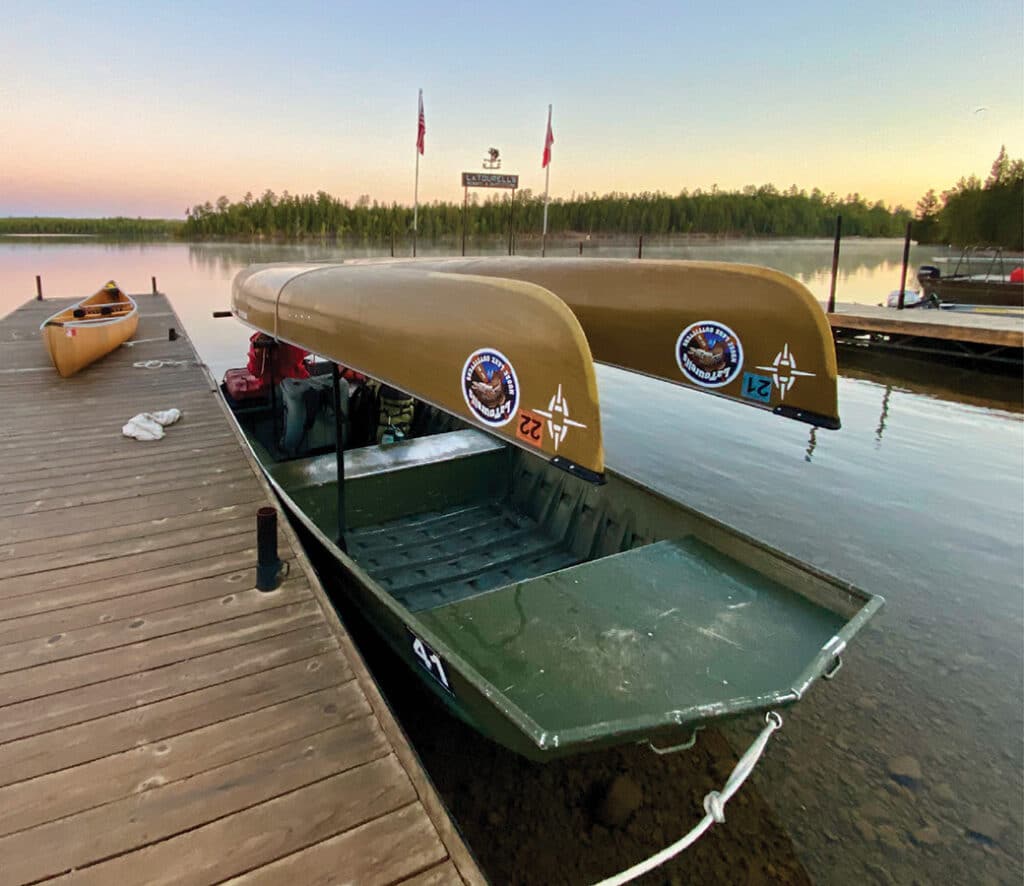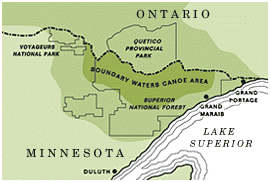
Wilderness Watch, an advocacy group for the National Wilderness Preservation System, recently filed another lawsuit against the U.S. Forest Service—Superior National Forest—regarding towboat management in the Boundary Waters Canoe Area Wilderness (BWCAW). The dispute began in 2015. Wilderness Watch claims that the agency has not enforced towboat rules and regulations in the wilderness.
April 30, 2025, update
The U.S. District Court in Minnesota held a hearing on Monday April 28, regarding the use of towboats in the BWCAW. Judge Nancy Brasel, who is presiding over the case, will decide whether the U.S. Forest Service-Superior National Forest (USFS) failed to regulate towboat use following established limits. Wilderness Watch, a nonprofit dedicated to protecting the National Wilderness Preservation System, brought the lawsuit against the federal agency. Both parties submitted their final briefs.
After the hearing, Wilderness Watch provided a video update. Executive Director, George Nickas said that, “We’ve been at it for a long time and we finally got our day in court and the Boundary Waters got its day in court.” He went on to add, “It’s the craziest thing that essentially we’ve got motorized taxies running around in the Boundary Waters Wilderness.”
According to a social media post from Paddle and Portage, the Forest Service argues that the court should dismiss the lawsuit and is currently reviewing the forest plan, which permits towboat use. A spokesperson for the USFS said they are unable to comment at this time. The judge has not issued a ruling yet, but we will provide an update once that happens.
___________________________________________________________________________________________________________________________
April 27, 2025 update
The Forest Service permits motorized towboats on several lakes and two rivers in the BWCAW. This service helps visitors reach remote areas more quickly and cross into Canada’s Quetico Provincial Park. Over time, however, the rules have evolved. The 1964 Wilderness Act restricted motorboat use to limited areas. Then, in 1978, the BWCAW Act imposed stricter limits. These included horsepower restrictions and caps on the number of motorized trips.
Below are the lakes where motorized boats are allowed with horsepower limits.
- Clearwater Lake (10 hp limit)
- North Fowl Lake (10 hp limit)
- South Fowl Lake (10 hp limit)
- Seagull Lake (10 hp limit; no motors west of Three Mile Island)
- Basswood Lake (no motors north of Jackfish Bay and Washington Island)
- Saganaga Lake (no motors west of American Point)
- Fall Lake (25 hp limit)
- Newton Lake (25 hp limit)
- Moose Lake (25 hp limit)
- Newfound Lake (25 hp limit)
- Sucker Lake (25 hp limit)
- Snowbank Lake (25 hp limit)
- East Bearskin Lake (25 hp limit)
- South Farm Lake (25 hp limit)
- Trout Lake (25 hp limit)
- Little Vermilion Lake (no hp limit)
- Loon Lake (no hp limit)
- Lac La Croix (no motors beyond the south end of Snow Bay on the U.S. side)
- Loon River (no hp limit)
Current numbers in conflict
In the 1978 BWCAW Act, Congress directed the Forest Service to identify and uphold the average level of all motorized use on lakes where it permitted exceptions. As a result, both current and future motorized use had to remain within the historic levels recorded between 1976 and 1978, but “shall take into account the fluctuation in use during different times of year”. However, the Forest Service later limited towboat use to “1992 levels for numbers of boats, trips, current operators, and specific lakes.”
In their recent filing, Montana-based environmental group Wilderness Watch claims the Forest Service has failed to follow legislation and its own Forest Management Plan. The group argues that the USFS has allowed excessive towboat traffic on certain lakes, such as the Moose Lake chain near Ely, which they describe as a “motorboat freeway, interrupting any semblance of contiguity across the wild landscape with a ceaseless parade of commercial and private engine traffic.”
Wilderness Watch gathered data from the USFS showing that the entry point cap for towboat trips on Moose Lake Entry Point #25 is 2,612. However, in 2018, commercial operators made 3,367 towboat trips from that entry point. During the same period, the agency issued 2,369 online public motorboat permits. As a result, they emphasize that the combined total exceeds the statutory limit.
Issue has been ongoing
This isn’t the first time the issue has reached the courtroom. Wilderness Watch first took the issue to court in 2015. The court settled the case with an agreement that the federal agency would spend a couple of years studying and addressing towboat use. In 2023, the group filed a second lawsuit to halt towboat services for the upcoming season, arguing that the USFS had not fulfilled its promise. They asked the court to suspend towboat services during the proceedings.
U.S. District Judge Nancy Brasel denied the request, expressing concern that halting towboat operations would disproportionately affect “older visitors and visitors with limited mobility.” She also noted that a complete ban would likely disrupt the Forest Service’s efforts to gather and analyze data on motorboat and towboat usage.
Over the years, the Superior National Forest has launched studies and gathered public comments to assess towboat use. Court documents submitted last year indicated that they are “currently in the midst of an extensive process to revisit all aspects of its management of the Boundary Waters, including towboats.”
In the past year, the agency acknowledged public concerns about towboat management within the motorized cap, as well as the impact they have on wilderness character. Consequently, they don’t dispute that specific standards and guidelines may need updates, adding the importance of “compliance with the statutory limits set in the 1978 BWCAW Act.”
Updating plans
While not specifically addressing the issues with towboats, Superior National Forest Supervisor Tom Hall has nevertheless responded to the need for change. “The management direction for the BWCAW was last updated in 1993,” Hall said. He went on to add, “Our implementation and monitoring over the past 30 years, and changes to national wilderness management policy and guidance, have highlighted several issues affecting wilderness character in the BWCAW and the wilderness experience for visitors.”
In an article from Paddle & Portage, Wilderness Watch conservation director Kevin Proescholdt expressed optimism that the court will enforce wilderness protections. “We hope the court will agree with us that the Forest Service must curtail commercial towboat use in the BWCAW to the levels required by the 1978 BWCAW Act and the agency’s own earlier pledge to the federal courts,” he said. “As well as conduct the detailed commercial needs assessment for towboats as required by the 1964 Wilderness Act.”
Regardless, the ruling could impact area outfitters who depend on towing services as a significant part of their business.
The hearing is scheduled for April 28 at 4 p.m. in the U.S. District Court in Minneapolis.
More info:
- Final Hearing to Decide Future of Towboats in BWCA Wilderness Set for April 28 – Paddle & Portage
- WW Sues to Stop Motorboat Abuse in Boundary Waters – Wilderness Watch

